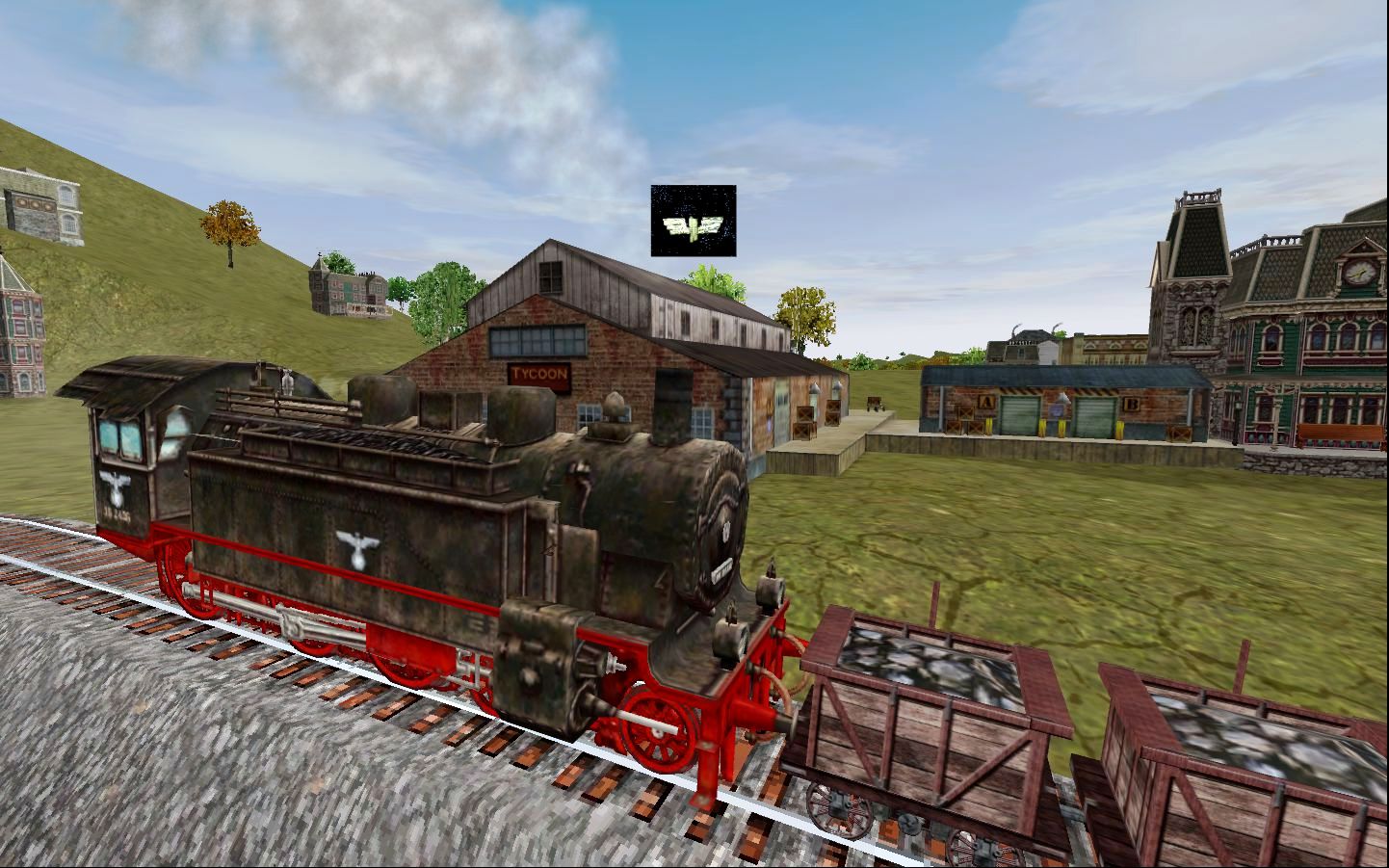requiring the unofficial 1.06 upgrade

Caution:
- Due to extensive modifications to the port/warehouse recipes as explained at the bottom of this page, any downloads of the map performed before January 25, 2021 must be replaced with the current one available here.
- It is strongly recommended that you create a separate RR Tycoon installation for this map. You can easily do this by dragging and dropping your RR Tycoon installation directory (while pressing the Control key) to any convenient place of your hard drive, or a removable one. Immediately afterwards, make sure to download and unzip this additional file in the "/Data/Language" location, so that the correct distances/speeds are displayed in the metric system. This map is dimensioned directly in kilometers!
- Please read carefully the Stop Press section and warning at the bottom of this page.Also, Download these industries here and unzip them in a dedicated RAILROAD TYCOON III installation ("./Data/BuildingTypes" subfolder), exclusively reserved for this base map.
So, in total you need 3 downloads to run this map.by Dipl.-Ing. Nikolaus Sbarounis
My earliest steps for the development of a proper and balanced Balkan base map, as well as accompanying scenarios date back to 2005, with long intervals of inactivity. A substitute located on the internet was rejected for being overly grotesque, with a carricature topography making it impossible to function. Specifically for the case of Greece, we have briefly examined 2 more decently crafted maps (one for the whole country and one for the Peloponnese) with accompanying interesting missions. With substantial improvements in the cargo/port/warehouse distribution patterns, both these maps will have a potential for greatly realistic sessions. For a continuation to the North, I would recommend working on this base map.Our map available here, which I am continuously working on, is in quasi-sandox status and has the following features:
- Scale: The distance figures given as miles, actually represent kilometers (a very good excuse to have trains "GO GO GO"-ing!). Ideally, someone should replace all "mile" references in the language file with "km" -I didn't so far-. Towns too close to each other, so as to fall within the catchment area of a single terminal, had their names and densities combined to imply a wider conglomeration incorporating them.
- Vegetation: You will notice some decent forests at few places. However, I found this to be obstructing both the view from train-mounted cameras, as well as the identification of important traffic sources, such as oil wells and small buildings. Therefore, I gave up the effort to re-create the look and feel of the actual locations for the sake of convenience and I recommend the same for any fellows that wish to re-develop this or any other maps, despite the barren impression that this may create.
- Lakes have not been included so far.
- Various industry density and frequency factor combinations were and are being tried, and I still consider this task far from finished. Right from the beginning, I have been painstakingly researching the characteristic industries of each of the nearly 200 featured cities and regions from many resources, including the local trade-and-industry chambers, as well as all industrial history citations that I was able to locate. At the same time I've been trying to prevent the whole production distribution from being overly predictable and deterministic. My testing so far indicates satisfactory statistical distribution of the various commodities' occurence across the map. Population densities mostly follow the proportion of the 1961 census by province, although some individual towns have been deliberately resized to enhance their transport interest.
- Commodity flow and distribution considerations:
- The South Balkans lack uranium sources and consumers. I felt reluctant to include the probability of nuclear power plants. However I didn't want to exclude uranium completely as a transit cargo, so I did provide respective import and export warehouses/ports.
- The South Balkans also lack coffee and rubber plantations. Relevant warehouses/ports take care of these essential commodities through exchange with native ones.
- Crystals and ingots, although available from the beginning, were wasting space purposelessly in the first decades of the 19th century. I made them meaningful by providing export warehouses/ports for them.
- Reversely, machinery is required straight from the beginning, yet not produced until later in the 19th century! I fixed this through respective importing warehouses/ports.
- Industries and compatibility: I made use of every single additional industry I could locate on the Internet listed below (including the Cereal Company by colleague architect Michael R. Rountree). However, the map has been verified to load smoothly even on "barebone" 1.06 installations, lacking any of the extra industries (of course omitting the missing ones when run).
- Borders: So far, due to spare time restrictions I have left the whole thing borderless, as it should be in the real world and as it has been through most of history. Another logic behind this was to study the natural, uninhibited flow of the various goods under an assumed unified economic regime. However at a later stage, the development of various era scenarios will inevitably make use of the respective national(-istic) borders and interstate relations.
- Place names: largely paraphrased and translated for amusement purposes, with some fooling around with the Byzantine & Latin alphabets. Many users will undoubtedly want to edit them at will. Also note that some localities too close to each other so as to fall within one terminal's catchment area, were combined into one. In such cases, the original place names were combined too. For instance, Trikala, Karditza and Kalambaka were combined into "Trikalambakarditza". Mind you that in such cases, the respective province populations and business densities were also summed together.
- Operating parameters: in the distributed file, I have greatly reduced loading/unloading times and locomotive water consumption to eliminate a frustrating "pain-in the-ass" together with the annoyingly frequent water stops.
- A semi-socialist economy. Startup with adequate cash enabling the purchase of promising industries that constitute good bargains along the expanding RR network.
- Continuous track-building possibility immediately after completion and testing of each new stretch. Overall economy development rates roughly balance the rate of new line building and testing, so that very few waiting periods are required either to accumulate tracklaying funds, or for additional industries to develop.
Under these prerequisites, tests have succesfully covered a continuous 80-year era from ca. 1830 to 1910, as well as the current half of the 21st century. Intermediate periods have yet to be tested.
No competing rail operators scenarios have been run yet, as long as the single-company options have not been thoroughly tested.
It has been verified that a good strategy is to start with short-to-medium profitable stretches radiating from the biggest cities (commonly Athens, Istanbul, Izmir, Bursa and Salonica). A delay to do so will result in housing expansion occupying any available strategic location of the main terminal and ruining the scenario potential for the rest of the time. In rare cases some metropolitan areas may appear straight from startup with no advantageous vacant space either for the main terminal or for its outside connection. In such a case it is preferable to try a new startover.
Personally, I absolutely reject any gradient steeper than 5%, preferring to make long detours, frequent switchbacks, relocate entire stretches of mainline or even terminals themselves if elevations get accidentally messed-up for any reason.
Needless to say, all the above is subject to discussion, which I want to encourage. Development of alternative scenarios for this base map, varying in any aspect, is also something I'd be highly interested to see.P.S: Balkans have Muslims too! Don't forget to download and install a mosque building
Support and enhance Railroad Tycoon III, the intriguing transport business simulation!
Stop press! MODIFICATIONS TO THE DEFAULT RAILROAD TYCOON III INDUSTRY MODEL TO SUIT THE DEVELOPMENT OF SOUTH BALKAN-BASED SCENARIOS
Download these industries here and unzip them in a dedicated RAILROAD TYCOON III installation ("./Data/BuildingTypes" subfolder), exclusively reserved for this base map. The evolution of the industry branches featured in RR Tycoon follows in a generic mode the timeline of the innovations applied in the technologically advanced, heavily industrialized world. In underdeveloped territories such as the South Balkans, this pattern will lead to highly unrealistic and out-of-place outcomes for the whole period between the mid-Victorian era and the end of WW II. Afterwards, the advent of socialism in most of the peninsula, as well as a modernization wave in the capitalist outposts of Greece and Turkey, reinstated a degree of compatibility and similarity with more civilized regions (at least to the extent of the "RR Tycoon"'s scope).As realized from online sources, during the aforementioned period the sectors of metallurgy, petroleum and automotive industry were virtually non-existent in the area concerned. Practically, all available raw materials of these sectors had to be exported to advanced countries, and their finished (or semi-finished) products imported into the Balkans.
From an initial approach, the following modifications seem advisable:Industry Proposed year of introduction Remarks/Notes Aluminum 1960's Steelworks 1938 Greece+Turkey simultaneously. Before WW II Yugoslavia reported negligible metallurgy (Source:CIA report on Yugoslavia) Oil refineries 1958 Oilfields 1930 First important discoveries in Albania Automobile plants 1952 This industry began with buses, then expanded to family cars. Rubber tyre plants 1960's Few references were found, notably in the "Commerce Reports", of the Bureau of Foreign and Domestic Commerce, Vol. 4,Num. 42, 1929, "Improved tire trade with the Balkans," it is clearly stated that "no domestic tire production exists" and "it will be some time before a domestic tire industry will be established in any of the states" Cement plants 1900-1902 Department Stores 1957 Insufficient urbanisation and the organisational structure of commerce prevented concentration of activities into such businesses. Also, delay of private auto usage made modern shopping malls unfeasible. In Greece, WW II left a certain bunch of black marketeers /Nazi collaborators controlling a disproportional part of commerce, the distribution of UN-humanitarian aid and the political scene, and these were able to transform their businesses into the present-day megamarket chains, aided also by the reactionary government's forced urbanisation policy.
The socialist Balkan neighbours from their own standpoint also began modernizing their trade more or less simultaneously.Shopping Malls 1995 Influence on the port & warehouse recipes
As a result of the above, in order to keep the rest of the economy going, it is necessary to provide import hubs for the following commodities:Automobiles, Aluminum, Steel, Oil, Diesel, Concrete and Tyres.
Not to forget, it was already necessary to provide for the import of rubber, dye and "Exotic foodstuff" (formerly "Coffee") due to their overall absence from the region. Furthermore, Machinery has also to be imported in the early 19th century because no provision exists for its manufacture.In addition, export hubs are required for the abundant Iron (after 1876) and Bauxite available not to be wasted. Mind that Ingots and Crystals had already to be exported in the early 19th century because no industries made any use of them.
Uranium will exist exclusively as transit cargo, since neither users nor sources of it are present in the area. The same has to apply for rubber prior to the -highly delayed- appearance of tyre plants.Obviously, these numerous constraints will largely determine the entire port & warehouse scene.Warning: - Users that will not download the modified industries available here are advised that the expected results between 1856 and 1960 will be highly unrealistic.
All the industry modifications suggested here will be necessary for the map to behave as intended by its creator.
- Please read carefully the Stop Press section and warning at the bottom of this page.Also, Download these industries here and unzip them in a dedicated RAILROAD TYCOON III installation ("./Data/BuildingTypes" subfolder), exclusively reserved for this base map.













Comments
Post a Comment